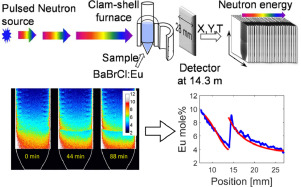当前位置:
X-MOL 学术
›
Acta Mater.
›
论文详情
Our official English website, www.x-mol.net, welcomes your feedback! (Note: you will need to create a separate account there.)
In-situ observation and analysis of solid-state diffusion and liquid migration in a crystal growth system: A segregation-driven diffusion couple
Acta Materialia ( IF 9.4 ) Pub Date : 2020-03-01 , DOI: 10.1016/j.actamat.2020.01.013 Anton S. Tremsin , Didier Perrodin , Adrian S. Losko , Sven C. Vogel , Takenao Shinohara , Kenichi Oikawa , Gregory A. Bizarri , Edith D. Bourret , Jeffrey H. Peterson , Kerry P. Wang , Jeffrey J. Derby
Acta Materialia ( IF 9.4 ) Pub Date : 2020-03-01 , DOI: 10.1016/j.actamat.2020.01.013 Anton S. Tremsin , Didier Perrodin , Adrian S. Losko , Sven C. Vogel , Takenao Shinohara , Kenichi Oikawa , Gregory A. Bizarri , Edith D. Bourret , Jeffrey H. Peterson , Kerry P. Wang , Jeffrey J. Derby

|
Abstract Energy-resolved neutron imaging is employed for in-situ measurements of dopant transport in a simple experiment performed before the crystal growth of the scintillator BaBrCl:5%Eu via a vertical gradient freeze technique. During a stabilization period preceding growth, we observed the diffusion of Eu from the solid phase into the melt over a period of approximately 4 hours. Comparing the measured centerline concentration profile with a mathematical model for the system, we estimate the solid-state diffusivity of Eu in BaBrCl as D 1 = 1.9 × 10 − 10 m2/s and an upper limit for the liquid-phase diffusivity of Eu in the melt as D 2 * = 2.5 × 10 − 10 m2/s, at temperatures near the melting point. We compare this experiment, where diffusion is driven by a concentration discontinuity arising from segregation, to the classical diffusion couple technique. Suggestions are offered on how this segregation-driven couple might be improved as a tool for measuring diffusion coefficients, and we draw attention to the great promise of neutron imaging for in-situ measurements of the distribution of elements, with sufficiently high neutron attenuation coefficients, in difficult environments.
中文翻译:

晶体生长系统中固态扩散和液体迁移的原位观察和分析:偏析驱动的扩散偶
摘要 在闪烁体 BaBrCl:5%Eu 晶体生长之前通过垂直梯度冷冻技术进行的简单实验中,采用能量分辨中子成像对掺杂剂传输进行原位测量。在生长前的稳定阶段,我们观察到 Eu 从固相扩散到熔体中约 4 小时。将测得的中心线浓度分布与系统的数学模型进行比较,我们估计 Eu 在 BaBrCl 中的固态扩散率为 D 1 = 1.9 × 10 − 10 m2/s 和 Eu 在 BaBrCl 中的液相扩散率的上限在接近熔点的温度下,熔体为 D 2 * = 2.5 × 10 − 10 m2/s。我们比较了这个实验,其中扩散是由分离引起的浓度不连续性驱动的,到经典的扩散偶技术。提供了关于如何改进这种偏析驱动偶作为测量扩散系数的工具的建议,我们提请注意中子成像对元素分布的原位测量的巨大前景,具有足够高的中子衰减系数,在困难的环境中。
更新日期:2020-03-01
中文翻译:

晶体生长系统中固态扩散和液体迁移的原位观察和分析:偏析驱动的扩散偶
摘要 在闪烁体 BaBrCl:5%Eu 晶体生长之前通过垂直梯度冷冻技术进行的简单实验中,采用能量分辨中子成像对掺杂剂传输进行原位测量。在生长前的稳定阶段,我们观察到 Eu 从固相扩散到熔体中约 4 小时。将测得的中心线浓度分布与系统的数学模型进行比较,我们估计 Eu 在 BaBrCl 中的固态扩散率为 D 1 = 1.9 × 10 − 10 m2/s 和 Eu 在 BaBrCl 中的液相扩散率的上限在接近熔点的温度下,熔体为 D 2 * = 2.5 × 10 − 10 m2/s。我们比较了这个实验,其中扩散是由分离引起的浓度不连续性驱动的,到经典的扩散偶技术。提供了关于如何改进这种偏析驱动偶作为测量扩散系数的工具的建议,我们提请注意中子成像对元素分布的原位测量的巨大前景,具有足够高的中子衰减系数,在困难的环境中。


























 京公网安备 11010802027423号
京公网安备 11010802027423号